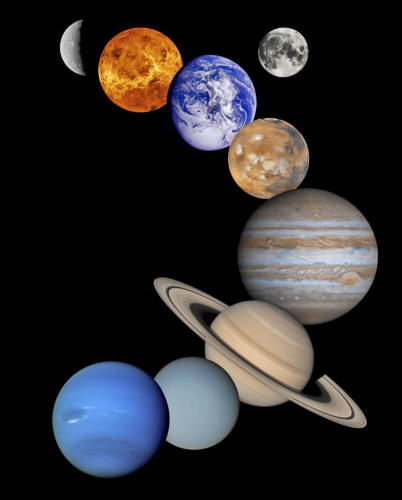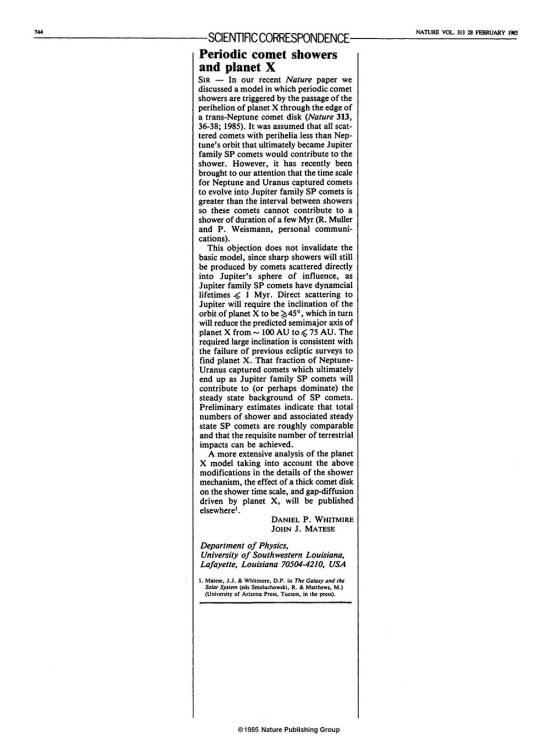|

by Bob Whitby
March 30, 2016
from
PHYS Website

Solar system.
Credit: NASA
Periodic mass extinctions on Earth, as indicated in the global
fossil record, could be linked to a suspected ninth planet,
according to research published by a faculty member of the
University of Arkansas Department of Mathematical Sciences.
Daniel Whitmire, a retired professor of astrophysics now working as
a math instructor, published findings in the January issue of
Monthly Notices of the Royal Astronomical Society that the as yet
undiscovered "Planet X" triggers comet showers linked to mass
extinctions on Earth at intervals of approximately 27 million years.
Though scientists have been looking for Planet X for 100 years, the
possibility that it's real got a big boost recently when researchers
from Caltech inferred its existence based on orbital anomalies seen
in objects in the Kuiper Belt, a disc-shaped region of comets and
other larger bodies beyond Neptune.
If the Caltech researchers are
correct, Planet X is about 10 times the mass of Earth and could
currently be up to 1,000 times more distant from the sun
Whitmire and his colleague, John Matese, first published research on
the connection between Planet X and mass extinctions (Periodic
Comet Showers and Planet X) in the journal
Nature in 1985 while working as astrophysicists at the University of
Louisiana at Lafayette:

Source
Their work was featured in a 1985 Time
magazine cover story titled, "Did Comets Kill the Dinosaurs? A Bold
New Theory About Mass Extinctions."
At the time there were three explanations proposed to explain the
regular comet showers: Planet X, the existence of a sister star to
the sun, and vertical oscillations of the sun as it orbits the
galaxy. The last two ideas have subsequently been ruled out as
inconsistent with the paleontological record.
Only Planet X remained
as a viable theory, and it is now gaining renewed attention.
Whitemire and Matese's theory is that as Planet X orbits the sun,
its tilted orbit slowly rotates and Planet X passes through the
Kuiper belt of comets every 27 million years, knocking comets into
the inner solar system.
The dislodged comets not only smash into the
Earth, they also disintegrate in the inner solar system as they get
nearer to the sun, reducing the amount of sunlight that reaches the
Earth.
In 1985, a look at the paleontological record supported the idea of
regular comet showers dating back 250 million years. Newer research
shows evidence of such events dating as far back as 500 million
years.
Whitmire and Matese published their own estimate on the size and
orbit of Planet X in their original study.
They believed it would be
between one and five times the mass of Earth, and about 100 times
more distant from the sun, much smaller numbers than Caltech's
estimates.
Matese has since retired and no longer publishes. Whitmire retired
from the University of Louisiana at Lafayette in 2012 and began
teaching at the University of Arkansas in 2013.
Whitmire says what's really exciting is the possibility that a
distant planet may have had a significant influence on the evolution
of life on Earth.
"I've been part of this story for 30 years," he said. "If there is
ever a final answer I'd love to write a book about it."
|



